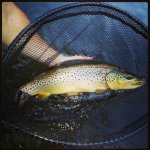SBecker
Active member
- Joined
- Jun 26, 2010
- Messages
- 5,660
The stream I fished I knew had a sulphur, march brown, tan caddis hatch going. I always carry olives and knew they would be a possibility. I actually thought I was pretty covered with what I needed.
I agree presentation is big. I proved that with the size 14 black bodied black parachuted egg laying grannom that I missed 2 takes on. However, those fish were really keyed into those size 18 spent apple caddis that I was not prepared with. The day was by far a loss and a highly enjoyable day.
I am one that is obsessive compulsive with certain situations. I will never give in and will pound away until I figure a fish out. I had to to be pulled away from these rising fish with the lure of other large fish rising to yellow mayflies. I am glad I was pulled away.
I would have went back the next day to establish my dominance over the pea brain pigs, but decided to spend the day with the kiddos.
Here is a little guy that my cousin caught on the new water.
I agree presentation is big. I proved that with the size 14 black bodied black parachuted egg laying grannom that I missed 2 takes on. However, those fish were really keyed into those size 18 spent apple caddis that I was not prepared with. The day was by far a loss and a highly enjoyable day.
I am one that is obsessive compulsive with certain situations. I will never give in and will pound away until I figure a fish out. I had to to be pulled away from these rising fish with the lure of other large fish rising to yellow mayflies. I am glad I was pulled away.
I would have went back the next day to establish my dominance over the pea brain pigs, but decided to spend the day with the kiddos.
Here is a little guy that my cousin caught on the new water.





